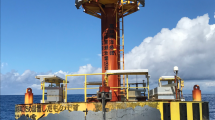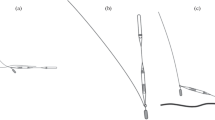Abstract
We have obtained precise estimates of the position of Ocean Bottom Seismometers (OBS) on the sea bottom. Such estimates are usually uncertain due to their free falling deployment. This uncertainty is small enough, or is correctable, with OBS spacing of more than 10 km usually employed in crustal studies. But, for example, if the spacing is only 200 m for OBS reflection studies, estimates of the position with an accuracy of the order of 10 m or more is required.
The determination was carried out with the slant range data, ship position data and a 1D acoustic velocity structure calculated from Conductivity–Temperature–Depth (CTD) data, if they are available. The slant range data were obtained by an acoustic transponder system designed for the sinker releasing of the OBS or travel time data of direct water wave arrivals by airgun shooting. The ship position data was obtained by a single GPS or DGPS. The method of calculation was similar to those used for earthquake hypocenter determination.
The results indicate that the accuracy of determined OBS positions is enough for present OBS experiments, which becomes order of 1 m by using the DGPS and of less than 10 m by using the single GPS, if we measure the distance from several positions at the sea surface by using a transponder system which is not designed for the precise ranging. The geometry of calling positions is most important to determine the OBS position, even if we use the data with larger error, such as the direct water wave arrival data. The 1D acoustic velocity structure should be required for the correct depth of the OBS. Although it is rare that we use a CTD, even an empirical velocity structure works well.
Similar content being viewed by others
References
Aki, K. and Richards, P. G., 1980, Quantitative Seismology Theory and Methods, Volume I, W. H. Freeman, San Francisco, CA, pp. 92–94.
Asada, T., Kanazawa, T., and Shimamura, H., 1979, A Pop-Up Type Ocean Bottom Seismometer, Prog. Abstr. Seis. Soc. Japan 2, 114 (in Japanese).
Berg, E.W., Amundsen, L., Morten, A., and Mjelde, R., 1996, Fluid Imaging Using Densely Spaced OBS-Data from the Vø ring Basin, EAGE 58th Conference and Technical Exhibition, Amsterdam, 3- 7 June, 1996, B027 (Abstract).
Creager, K. C. and Dorman, L. M., 1982, Location of Instruments on the Seafloor by Joint Adjustment of Instrument and Ship Positions, J. Geophys. Res. 87, B10, 8379–8388.
JWA (Japan Weather Association), 1981, Manual on Oceanographic Observation, Japan Meteorological Agency, Tokyo, 169 (in Japanese).
Jackson, D. D. and Matsu'ura, M., 1985, A Bayesian Approach to Nonlinear Inversion, J. Geophys. Res. 90 (B1), 581–591.
Kanazawa, T., 1986, New Ocean Bottom Seismometer System with AcousticRelease, Prog. Abstr. Seis. Soc. Japan 2, 240 (in Japanese).
Kanazawa, T. and Shiobara, H., 1994, New Ocean Bottom Seismometer System for a Dense Survey, Abstr. Japan Earth Planet. Sci. Joint Mtg., I11-P82, 341 (in Japanese).
Mjelde, R., Strø m, A., Berg, E. W., Shimamura, H., Kanazawa, T., Shiobara, H., Kodaira, S., and Fjellanger, J. P., 1993, Cruise Report: Investigation of the Central and Northern Part of the Vø ring Basin by Use of Ocean Bottom Seismographs, STATOIL-Report.
Mjelde, R., Berg, E. W., Strø m, A., Riise, O., Shimamura, H., Shiobara, H., Kodaira, S., Kanazawa, T., and Fjellanger, J. P., 1996, An Extensive Ocean Bottom Seismograph Survey in the Vøring Basin, N. Norway, First Break 14, 247–256.
Mochizuki, M., 1996, Crustal Structure and Microseismicity of the Mid-Atlantic Ridge, Near Iceland, Derived from Ocean Bottom Seismographic Observations, Dr. Thesis, Hokkaido University (in Japanese).
Nakagawa, T. and Oyanagi, Y., 1982, Experimental Data Analysis by Least Squares Method - Program SALS, University of Tokyo Press, Tokyo, 65–72 and 99- 110 (in Japanese).
Nakamura, Y., Donoho, P. L., Roper, P. H., and McPherson, P. M., 1987, Large-Offset Seismic Surveying Using Ocean-Bottom Seismographs and Airguns: Instrumentation and Field Technique, Geophysics 52, 1601–1611.
Nakanishi, A., Shiobara, H., Shimamura, H., Hino, R., Murayama, T., Nishisaka, M., Aoyagi, Y., Asanuma, T., Shinohara, M., Fujie, G., Mochizuki, K., Sato, T., Koresawa, S., Kasahara, J., Taka hashi, N., Araki, E., Kido, Y., Igarashi, C., Toh, H., Tokuyama, H., Suyehiro, K., and Segawa, J., 1996, Detailed Crustal Structure of a Complex Plate Collision/Subduction Zone, the Eastern Nankai Trough, Japan, Prog. Abstr. AGU Fall Meeting, EOS Trans. 77, T72C-3, F657.
The Scientific Members of the Cruise KH-96-1 (J. Segawa and S. Ohta, eds.), 1996, Preliminary Report of the Hakuho-Maru Cruise KH-96-1, February 23- March 21, 1996, The Nankai Trough (KAIKO-TOKAI, ODP), Ocean Research Institute, The University of Tokyo.
Shimamura, H., Stefánsson, R., Mochizuki, M., Watanabe, T., Shiobara, H., Gudmundsson, G., and Einarsson, P., 1996, Northern Reykjanes Ridge Microseismicity Revealed by Dense OBS Arrays, ESC Seismology in Europe, Papers presented at the XXV General Assembly, Reykjavik, 9- 14 Sept., 1996, 491–497.
Wessel, P. and Smith, W. H. F., 1995, New Version of the Generic Mapping Tools Released, EOS Trans. Amer. Geophys. U. 76, 329.
Wilson, W. D., 1960, Speed of Sound in Sea Water as a Function of Temperature Pressure and Salinity, J. Acoust. Soc. Am. 32, 641–644.
Author information
Authors and Affiliations
Rights and permissions
About this article
Cite this article
Shiobara, H., Nakanishi, A., Shimamura, H. et al. Precise Positioning of Ocean Bottom Seismometer by Using Acoustic Transponder and CTD. Marine Geophysical Researches 19, 199–209 (1997). https://doi.org/10.1023/A:1004246012551
Issue Date:
DOI: https://doi.org/10.1023/A:1004246012551




